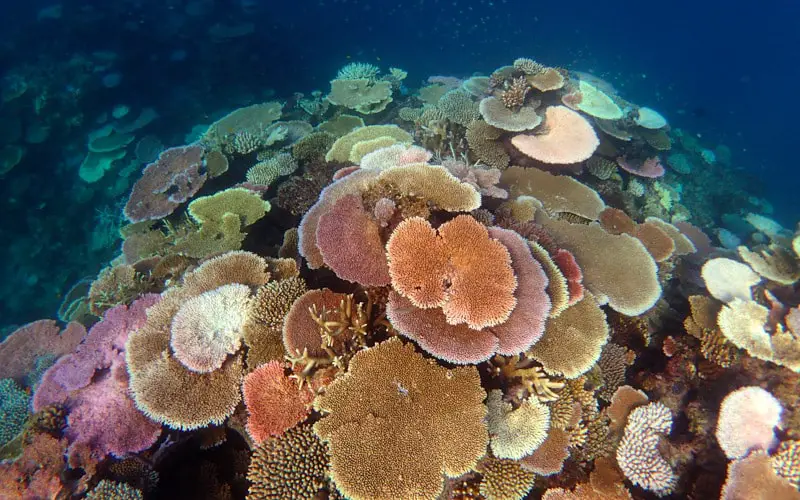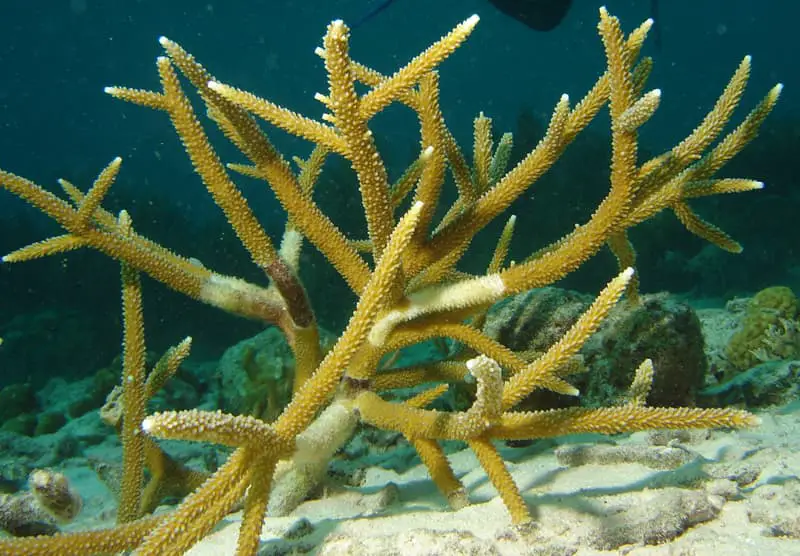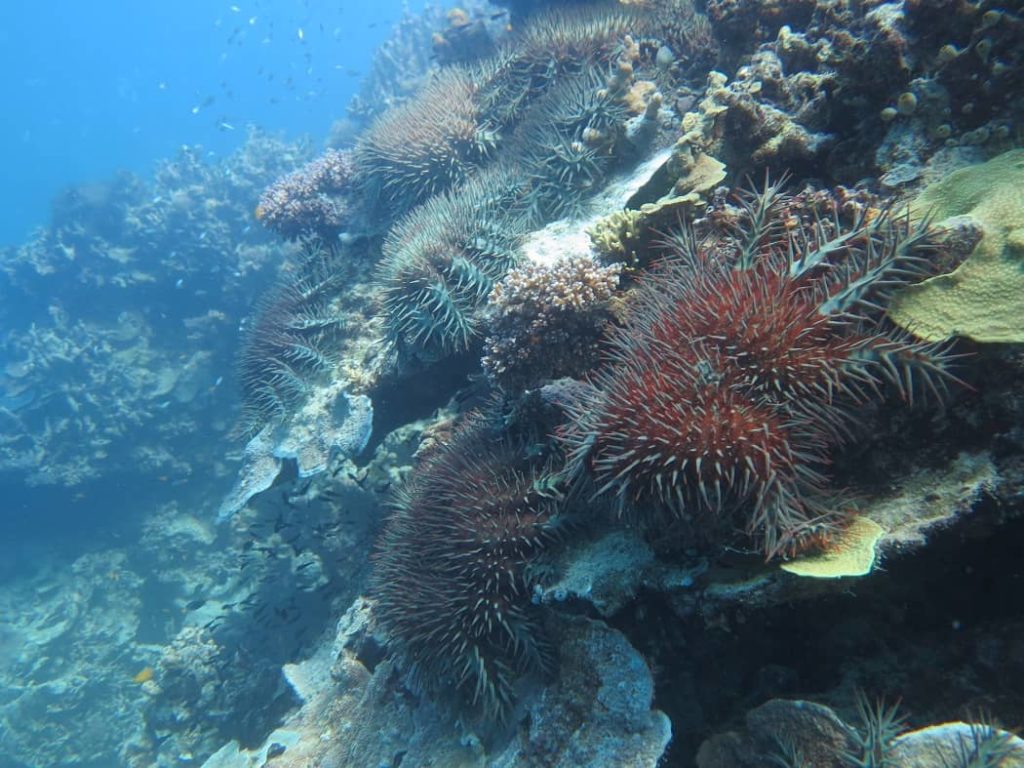What Do Crown Of Thorns Starfish Eat?
As you may already know, Crown-Of-Thorns starfish is a major cause of coral loss on the Great Barrier Reef. Its plague proportions and eating habits devastate coral communities. If you wonder what exactly this starfish eat, in this post we’ll talk all about that. However, let’s start with a quick answer:
Crown-Of-Thorns starfish are known for being corallivore which means they feed on coral. Generally, they prefer hard corals like table and branching corals but they have been found also eating sponges, soft corals, algae, and encrusting organisms.
However, that certainly doesn’t tell the whole story. Below I’ll explain what exactly these starfish eat, how and how much they eat, what animals eat them, and explain the outbreak problem. Read on!
What do Crown Of Thorn Starfish eat?
Crown of Thorn Starfish (also known as COTS for short) are the second-largest sea star in the world and can grow to be over half a meter wide (or around 1.6 feet). They are covered in venomous spines all around their body and like other members of the phylum Echinodermata, they use their spines to move around the seafloor and to protect themselves. However, not the size that makes these sea stars so popular but their feeding habits.
Crown of Thorn Starfish are known for being corallivore, which means they feed on coral. They prey on nearly all corals but their feeding preferences and patterns can vary and depend on water motion, species composition, and population density. Generally, they prefer hard corals like table and branching corals.

Table corals form broad horizontal surfaces. They are called “extraordinary ecosystem engineers” because they can regenerate coral reef habitats faster than any other coral which means they play a huge role in reef recovery. These unique corals are incredibly important not only because of their rapid growth but also because some species’ lives are entirely dependent on them. Their large plate-like surface is vital sun protection for large fish in shallow waters and shelter protection for small fish species.

Branching corals are the most recognizable corals and create a home to 25 percent of all tropical fish. They are having branches coming off the first branch which makes them branch like a tree. Their lengths, hardness, and thickness vary depending on the species. Both table and branching corals are very vulnerable to bleaching. However, Crown Of Thorn Starfish will also feed on other hard corals like Porites or Motipora. They have been found feeding also on sponges, soft corals, algae, and encrusting organisms.
Unfortunately, Crown Of Thorn Starfish eat corals faster than they’re able to grow what creates a massive problem for coral restoration. In the Great Barrier Reef, they are a second major cause for coral loss, right after the coral bleaching.
Baby Crown Of Thorns Starfish diet
What worries scientists is that larvae and juvenile starfish are unfussy and adaptable eaters. They are very flexible and at an early stage of their life they feed on a broad range of algae, but only the algae they thought they prefer. They also feed on crustose coralline algae, and to avoid starvation, they can even subsist on microorganisms that cover almost all surfaces in the ocean, called biofilm. Baby starfish can survive for up to six and a half years on algae.
How does Crown Of Thorn Starfish eat?
In order to eat corals, Crown Of Thorn Starfish lies on top of them and wraps its stomach around. COTS doesn’t bite the coral but digests the thin layer of soft tissue off of a coral’s skeleton. Next, it sucks down the available nutrients. The body of Crown of Thorn Starfish has a stiff appearance however it’s able to bend and twist to fit around the corals.
Like other sea stars, COTS has two stomachs – the cardiac and the pyloric stomach. It pushes the cardiac stomach out of its mouth first and inserts it into a coral. Next, the cardiac stomach comes back into the body, and the food is transferred to the pyloric stomach.
How much does Crown Of Thorn Starfish eat?
Each individual can consume 6-10 square meters (65 – 107 sq ft) of living coral per year. Feeding rates may vary with the changing temperature but the central GBR studies noticed that large adults consume as much as 478 cm2 (0.5 sq ft) of coral per day in summer.
What’s interesting about these species is that they can survive without food for nine months!
What eats Crown Of Thorn Starfish?
Crown of thorn starfish is a difficult prey target to many predators on the reef. COTS is covered by venomous spines all over its body which is dangerous to both humans and marine creatures. The main predators of the COTS are the giant triton snail, pufferfish, the titan triggerfish, the humphead wrasse.
Predators of juvenile starfish are mostly marine invertebrates including crabs, shrimps, and polychaete worms. However, the amount of predators is decreasing due to overharvesting and climate change which may be a cause for a high density of COTS.
Crown Of Thorn Starfish outbreak

Unfortunately, COTS predators aren’t enough, and the number of these sea star species causes a situation where their density exceeds the level that the available resources can sustain. The COTS outbreak cause is not exactly known, but scientists agree that it can be something with an increased level of nutrients in the water due to global warming or agriculture runoff. This leads to plankton bloom which is an essential food source for sea star larvae.
Removing or killing starfish is, so far, the best method to control the outbreak. Divers have been injecting a mixture of bile salt or vinegar into starfish, which kills them within 24 hours. The amount of divers and the rate however is still not enough to solve this massive problem on the Great Barrier Reef in Queensland. That’s why researchers at Australia’s Queensland University of Technology (QUT) seek ways to destroy COTS and they have invented a robotic “terminator” called COTSBot.
This robot is equipped with cameras, GPS, sensors, thrusters, and a pneumatic injection arm to deliver a shot. If this process safely speeds up, it may have an important role in limiting the outbreaks of this starfish and hopefully will increase our chances of coral restoration.
You may also like:

Welcome to Bubbly Diver!
I’m glad to see you here. This blog is created for all marine creature lovers by a bubbly diver - me, Dori :)


